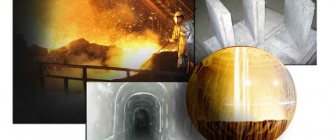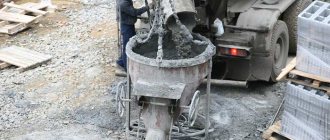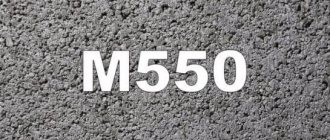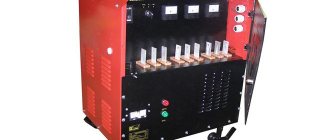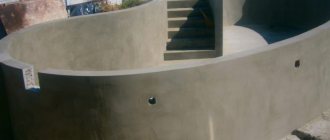- 1 Types of gutters 1.1 Suspension device
- 1.2 Gutter structures with jibs
- 1.3 Tray for truss-type concrete mixture
Gutters are a structure for draining or mechanically transporting liquid to the desired location. Such a device is a useful, effective assistant both in everyday life and in industrial conditions, in the road system, and the construction industry. It is the construction type of gutters that will be discussed. A construction gutter for concrete is a simple design that you can actually make with your own hands. With such a gutter it is possible to ensure high-quality, uniform placement of concrete mortar during the construction of the foundation for a building.
Types of gutters
There are several types of gutters for pouring concrete:
Return to contents
Hanging device
It is used when transporting concrete mortar over a short distance with a shift to the site of the future foundation. To build this mechanism, you need to take a rope and attach a tray to it using cables threaded through a couple of blocks. One end of the rope is tied to a column or pole. A weight is attached to the other and left on the ground. The load should also be hung on the edges of the cables so that it is convenient to adjust the degree of inclination of this mechanism.
If a massive foundation is being laid for a large project, a fixed angle of inclination of the concrete conveyor should be installed. This can be achieved by increasing the height of the tower or installing additional columns. Actually, the mixture from the central tower will be transferred to these additional pillars.
Return to contents
Gutter structures with jibs
Diagram of a trench for pouring concrete.
Such a device is a mechanism in which the lower edge of the tray is attached to a jib - a lattice structure made of metal, one edge of which rests on the lower slide, the other is connected to the upper ones by means of a lifting cable. To maintain stability of the angle of inclination of the gutter, the lower edge of the structure is attached to the ground using cables. This device is used when delivering concrete composition to the formwork at a distance not exceeding 60 meters.
Return to contents
Truss-type concrete mix tray
The simplest mechanism for delivering concrete to the foundation site of all those listed. It is a design in which the lower edge of the concrete conveyor is attached to a support.
Return to contents
Types of devices
Types of equipment for concrete Such equipment is used to supply concrete mortar to the formwork or to the place where it is laid in small portions.
Concrete bunkers are available in two types:
Bucket glass for concrete
Universal products can be equipped with a sleeve.
Bucket shoe for concrete
Both options are used if unloading equipment is available. Such buckets for concrete mortar are produced in small volumes: from 0.5 m³ to 3 m³. This allows you to move structures with any mobile crane or manipulator.
Sizes of structures for different volumes
Purpose of concrete trays
Such a structure is intended for pouring mortar into the formwork of the future foundation of the building. From the concrete mixer, the mixture is supplied through a chute to its destination. However, if concrete is poured at the same point, then due to the uneven placement of the mixture, a flat surface of the designed foundation will not be obtained.
In this case, beware of delamination in concrete, when the watery part of the solution flows into the far corners of the formwork, and the denser part remains at the pouring point. By making mistakes when supplying the concrete mixture using a special tray, you can create a low-quality foundation that will soon begin to deform.
Therefore, be sure to create conditions for the smooth movement of the concrete mixer around the construction site so that there is access to any corner of the future structure. If in some places this is not possible, the length of the gutter should be increased in order to reach hard-to-reach corners.
Return to contents
Features of using the equipment
Using a bucket to deliver concrete to a construction site
Before getting acquainted with the types of containers for supplying concrete, it is worth determining what they are needed for and the advantages of the equipment.
Concrete buckets are used:
The solution must be supplied to the container under certain conditions.
These include:
- Ability to carry out work at a relatively low speed;
- The need for equipment to lift the tub;
- Possibility of delivering the train to the loading site;
- Several workers must unload this bunker.
When doing monolithic construction with your own hands, such a container is not always needed - modern stationary concrete pumps easily supply the solution over hundreds of meters.
Even systems with smaller capacities mounted on a truck chassis can perfectly cope with delivering the composition to formworks located at a height of up to 30 meters. But the cost of such a process is quite high.
Preparation of materials and tools for creating a gutter
When producing a transport mechanism for a concrete composition, pay attention to some points:
- This device must be in close contact at one end with the mixer, at the other with the formwork, thus connecting them.
- Install the device with a certain angle of inclination so that it is easier for the concrete under its own weight to flow down the gutter into the formwork.
Tools that may be needed at work.
To create such a mechanism, you will need the following tools:
- hacksaw;
- roulette;
- hammer;
- screwdriver;
- square;
- Bulgarian.
To do this you will need to prepare the following materials:
- board measuring 2.5/12 cm;
- a piece of polyethylene, linoleum or tin;
- timber or block as a support;
- nails (you can use screws).
Return to contents
Layout diagrams
Attachment system
It is used in this case if the supply of concrete for pouring the structure (it is the foundation itself) is carried out over a small distance with an offset. To create such a structure, a rope is useful, to which the gutter is suspended using cables passing through two blocks.
One end of the rope is attached to a pole or column, and a load is hung on the other end and lowered to the ground. The load is also hung on the ends of the cables in such a way that they can be used to adjust the angle of inclination of the system.
If you plan to build such a system as a foundation for a huge structure, then to maintain a constant angle of inclination you need to install a higher tower for the rope or install additional pillars. Specifically, concrete will be supplied to the auxiliary pillars from the main tower.
Gutters with jibs
This arrangement is appropriate in this case if the concrete for the foundation is supplied at a distance of less than 60 meters.
The lower end of the gutter is suspended and attached to the jib.
The jib is an iron lattice truss, one side of which rests on the lower skid, and its upper edge is connected to the upper skid using a lifting cable.
In order for the slope of the gutter to remain constant while the concrete solution passes through it, its lower end is attached to the ground using cables.
Sprengel groove
A more common design that involves hanging the lower end of the gutter from a support.
Tips for making troughs for pouring concrete mortar
Before starting the production of a concrete delivery tray, it is worth paying attention to some conditions regarding setting the correct angle of the structure. The degree of the established inclination must be stable and the same throughout the entire working process. As the slope decreases, the flow of the concrete solution slows down . The consequence of this may be premature hardening or clogging of the mixture.
Pouring concrete through a chute into the formwork.
If the angle of inclination of the gutter, on the contrary, becomes even greater, the speed of transport of the solution inside the formwork will increase. This is fraught with the disintegration of the mixture into different parts, which can lead to a significant deterioration in the quality characteristics of concrete. The foundation will lose its performance qualities, become fragile, vulnerable and short-lived.
The angle of inclination for installation of the gutter structure is selected taking into account the level of supply range of the concrete mixture and its density coefficient. For liquid solutions conveyed over a shorter distance, a small level of inclination is permitted. If the composition is sufficiently dense or it is delivered over a long distance, the angular degree of the tray should be increased as much as possible in order to speed up the pouring process and not deform the structure due to the weight of the concrete mass.
The uniformity of the concrete composite is influenced by the shape of the gutter structure. A long, narrow tray, made with your own hands, during the delivery of the solution contributes to a closer connection of its grains. At the same time, the trench should be made quite deep to prevent the concrete solution from overflowing over the edges of the tray while pouring the foundation.
If the manufactured device transporting concrete from the mixer to the formwork turns out to be too narrow, it must be strengthened with horizontal crossbars. This will protect the structure from deformation during the thrombotic process of the concrete mass. If you want to give the structure greater strength, you can increase its hardness by means of corners attached to the tray perpendicularly. The length of such fasteners must correspond to the width of the gutter.
Today, similar mechanisms for laying foundations are produced from 3 to 15 meters in length. Such devices, as a rule, are used for more global purposes - in the construction of large-scale commercial, often multi-level structures.
Under private construction conditions, shorter (up to one and a half meters), convenient gutters are suitable, which are quite possible to make with your own hands. Its weight also depends on the footage of the tray. The longer the structure, the heavier it should be. This will protect the solution conveyor from bending under the weight of the mass entering it.
Return to contents
Operating procedure
- Depending on the width of the existing boards, the bottom of the tray box is assembled - 4 (150 mm) or 3 (200 mm) boards in a row are connected into an “end” with an overlay from the same board nailed to the underside of the bottom of the box. For strength and reliability, also on the bottom side of the box with a step of 600-800 mm to the bottom of the box, reinforcing bars 40x40 mm are nailed across;
- The walls of the tray are nailed to the sides of the bottom of the box, and best of all, the walls of the tray are screwed with self-tapping screws, so as to form a U-shaped structure;
- The bottom of the tray is covered with galvanized (roofing) iron, or is not covered if the boards are carefully planed;
- For reliability and strength, the walls of the tray are “bandaged” with 40x40 bars in increments of 0.8-1 meter.
The concrete transport tray itself can be considered ready for use. But there is one caveat. In order for the material to move into the formwork from an automixer or concrete mixer as independently as possible, it must have a slope to the soil surface of 5-15 degrees (for “liquid” concrete) and 20-30 degrees (for thick concrete).
In addition, the concrete tray should not bend under its own weight and the weight of the concrete. This can be achieved in several ways: pin up available materials under the tray (foam blocks, boxes, bricks, etc.) or spend a little time and knock down special triangular trestle supports of different heights from 50x50 mm timber and lay the tray on them as if on a bed.
Also, for the convenience of “turning”, it is advisable to provide two handles in the part of the structure facing the formwork - a 50x50x1000 block nailed to the bottom of the tray, 250-300 mm away from the edge.
Useful practical tips! After you have poured the structure furthest from the mixer, you can cut off part of the tray with a hacksaw and grinder, break the handle for “turning” and continue working without moving the automixer or concrete mixer.
After completion of the work, the tray is disassembled into components that can be used for other construction or repair purposes.
Considering that some companies charge extra for the downtime of an automixer, to speed up the work of delivering concrete to the formwork, use two workers with shovels to stand on either side of the tray and shovel the concrete to the pouring point.
The process of creating a trough conveyor for concrete mass
Jet chute diagram.
It is not at all difficult to build such a mechanism with your own hands. This is a simple process that does not require professional skills and abilities. First, use a saw to cut the board, adjust it to the dimensions of 2.5 by 15 cm, and knock down a shape resembling the letter “P.” The sides of this structure must be high so that the concrete solution does not stagnate during transportation.
To facilitate the flow of the solution along the tray, the entire inside of the structure must be covered with smooth materials: polyethylene, tin or linoleum. This will ensure better sliding of the solution and reduce its adhesion to the bottom and walls of the conveyor.
After making the trench device for pouring the foundation, it is placed in the required place, supported by four supports. The role of such supports can be perfectly fulfilled by gas silicate or other monoliths that can protect the means of transporting the composite from collapse.
You should know that inside elongated open-type structures, a specific percentage of moisture evaporates from the concrete mixture, thereby disrupting the homogeneity of the solution. Therefore, such transport mechanisms are used only at private construction sites.
When laying foundations for industrial purposes, gutters are used, constructed in such a way that at the bottom of the device, before entering the formwork, the concrete passing through the tray is constantly mixed. This is done with the help of a special trunk pipe, reminiscent of a funnel, through which the solution passes.
Return to contents
Rules and tools
Jet chute diagram.
To build the structure you will need:
- roulette;
- hacksaw or chainsaw;
- hammer;
- Bulgarian;
- screwdriver;
- square
When pouring a foundation with your own hands, it is very important to follow some rules, the main ones of which are the following:
- concrete should be poured with a mixer in small portions, no more than 1.5 m in height, evenly distributing it over the entire surface area;
- the poured mixture must be compacted using a device such as a vibrator;
- pouring concrete using a mixer should proceed until it reaches the control mark, which is made on the surface of the formwork, i.e. then the filling stops;
- the concrete surface is well leveled, and after 3 hours, when the solution has set a little, it is covered with burlap;
- the foundation should not be poured from a mixer in small portions, which, in turn, will lead to the formation of joints that reduce the strength of the foundation, which can subsequently lead to the destruction of the structure;
- if the work is carried out in hot sunny weather, then the concrete surface is periodically moistened for several days.
Do-it-yourself chute for a concrete mixer - Metalworker's Guide
A gutter is a device used in the process of diversion and delivery of solution to the required location.
The household, industrial and construction sectors have armed themselves with the mechanism. We will talk about the latter.
The product is easy to assemble with your own hands, saving on the involvement of specialists and reducing the cost of physical resources. Uniform placement of concrete is guaranteed, and the time spent on construction will be significantly reduced if you take into account the specifics of manufacturing and installation.
Find out how to make a gutter yourself, efficiently. Use the recommendations below.
Why do you need a gutter?
Concrete solution comes from a concrete mixer there. The recommended length of the device is 1.2-1.5 m, then the concrete will be distributed evenly over the formwork. This is possible by providing free access to all areas of the building, including the most inaccessible ones.
Concrete delamination is prevented - without using this product, the thick solution will concentrate in the pouring area, and the liquid mass will spread over other areas. The correct approach to work will extend the life of the foundation by improving the quality of installation.
The gutter will reduce the mechanical impact on concrete - there will be no need to use shovels, and the work process will speed up.
Pouring the foundation for a house with your own hands
This is the last stage of work on constructing the foundation of any structure. Everything else - waterproofing, insulation - already falls into the category of surface finishing measures. The foundation is poured in various ways, depending on local conditions.
It is assumed that everything has already been prepared - the formwork has been installed, the “sand cushion” has been installed, and the reinforcement frame has been placed. It's a matter of concrete. Let's consider how to pour the foundation for a house yourself, depending on where and how the solution is prepared.
This is determined by expediency. It is necessary to take into account not only the price range for consumables or finished products, but also labor costs, as well as the availability of time, labor, and the possibility of a special vehicle reaching the required distance from the formwork.
Concrete mixer
The production of concrete mortar is organized directly at the construction site.
When choosing an installation, you should take into account that the speed of pouring the foundation yourself depends on the capacity of its drum.
The capacity of the most compact household mechanisms is in the range of 50 (0.05 m3) - 65 liters.
It is clear that even having automated the process of preparing the solution, it will be quite problematic to cope with such work on your own if the foundation is being built for a large structure, and not for a small building such as a garage or a country house.
The number of operating cycles directly depends on the performance of the installation. On average, it will take up to 5 minutes to produce 1 “portion” of concrete. This is determined to a greater extent by the size of the filler fractions (crushed stone, gravel).
To this you need to add the time for reloading the solution into a container (bucket, stretcher) and delivering it to the pouring site. At an average pace, about 0.2 m3 of concrete can be laid in formwork in 1 hour.
This technique (alone) is usually used if, for example, pouring a pile foundation is done on your own.
Example of work organization
As it becomes clear, the process of independently preparing a solution and building a foundation is quite labor-intensive. It takes a lot of time, but the concrete begins to gradually “set.” It is advisable to highlight the main technological operations and assign 1 person to each of them.
As option 1 - 2, they are engaged in loading the concrete mixer drum and the process of mixing the solution. Another one is by bringing ready-made concrete to the formwork and pouring it. To compact the solution and remove air trapped in its mass, 1 worker is also sufficient. With such an organization, the process will go on continuously.
As a rule, it is not possible to complete the filling in a day. Calculate so that there are, if possible, no more than 2 layers.
If the second “portion” is to be laid the next morning, then the tape is covered with film (polyethylene) overnight. The next day, the resulting “milk” is washed off, and the filling of the solution continues.
But if the break in work is more than a day, then you will have to wait until the upper cut of the lower layer hardens sufficiently.
There is a lot of debate around the question of how to fill - in layers or “compartments”, in parts, then connecting such “blocks” together. For individual construction, in which a shallow foundation is mainly constructed, this is not important. Just make sure that there are no frame rods sticking out at the joints of the strips (“blocks”).
And second. If the productivity of the concrete mixer is low, then it is better to do the pouring in parts, up to the upper level of the formwork. When “laying” the solution in horizontal layers, the layers will turn out to be thin, and this is undesirable.
The cost of pouring a foundation when preparing concrete yourself will be slightly lower than when using a purchased solution. It is determined by the cost of building materials: components for the mortar (primarily cement), reinforcing bars, wood for formwork.
It is different for each building, so you can only rely on the price lists of specialized companies, making allowance for the fact that the filling work is carried out on your own.
On average, for the installation of a strip foundation by workers from a third-party organization (taking into account the cost of materials), you will have to pay approximately 10,000 - 12,000 rubles per linear meter.
But this is for a shallow foundation.
"Mixer"
This is what people call a concrete mixer. 1 vehicle can bring from 4 to 8 m3 of ready-made solution to the site.
Depending on the size of the “tape,” in order to finish pouring the concrete foundation with a mixer on the same day, you can pay for the simultaneous arrival of several machines. However, there are some nuances here.
How close can the equipment get to the “unloading” site? If there is such a possibility, then the task is significantly simplified.
The machine will have to move along the formwork so that the solution is laid evenly along the entire perimeter of the structure. It is unlikely that it will be possible to scatter it manually, especially considering that there is a reinforcement assembly inside the fence, not to mention the quality of the resulting foundation.





